








It was a shock to the senses returning to Thamel, the tourist hub of Kathmandu Valley, after the serenity of the mountains. It was a familiar spot though, and we were grateful to be reunited with clean clothes, and a hotel room with a guaranteed hot shower and electricity. We had a long list of admin to work through again, with the priority being laundry, job interviews and yummy food !! While we weren’t entirely sure what we’d be doing next, we did decide that there would be no more immediate hiking, and decided to donate our well-loved hiking boots. We found a cool local charity called KEEP, an organisation providing second-hand trekking gear to porters. We were happy to see our boots go to a good cause after witnessing many porters were trekking the Himalayas in sandals.






While enjoying our local curry & naan shop for lunch, none other than our friendly Aussie mate from the NT Ranid walked past and poked his head in. The most old-school guy we’ve met in a while, he refused the offer to exchange whatsapp numbers like most travellers, instead agreeing to meet us at a local bar called Sam's Bar at 4pm for a drink. True to his word, Ranid was there at at the bar at 4pm, with a handwritten note with his email address so we could keep in touch in the future. It was a humbling reminder of what travelling used to be like before the dawn of instant messaging. "I'll meet you at this place at this time". Awesome.






We had 2 full weeks to kill before our flight from Kathmandu to Delhi, and were a little lost as to what to do with this time. It was a lot colder than when we first arrived in Kathmandu 2.5 months prior. Jelley needed a solid recovery, and we looked at all options to try to find a warm beach location in SE Asia, but it turns out Nepal is pretty far from everything!! The other option was Bhutan, but when we researched visiting the elusive country, it turned out it was going to be an extremely expensive exercise. Just the cost of the visa alone was going to be USD$200 per person per day in addition to other travel costs!! After some re-consideration, we decided to stick around in Nepal, and explore the other pockets of Kathmandu Valley that we hadn’t been to yet, including the remaining 2 former kingdoms of the valley.
Before any more exploring though, we were craving a sense of normality and home base, so booked a wonderful Airbnb with a rooftop terrace close to the expat area of the city, on the border of what is known as Patan or Laliptur. It was just what we needed, a little break from being in Nepal, and we took joy in walking on footpaths, not feeling like we were dodging an accident every time we set foot outside the door.






Our German friends from Gokyo Lakes, Maike & Eva, were also staying in Patan, and we enjoyed reconnecting again and sharing stories from the end of our trek after we partied ways. Maike was headed home, but Eva was staying for another couple of weeks, and it was nice to have a friend to regularly catch up with and explore cafe and restaurants in the neighbourhood.
Jelley was on the tail-end (finally!!) of her Khumbu Cough, but it was now Luke’s turn to be under the weather. We took it very easy, eating good food, watching Christmas movies, catching up with family on long-overdue calls, eating lots of donuts, doing some wedding planning and resting a lot.






We did find the energy for a few tourist activities. The first being a visit to Boudhanath, a UNESCO World Heritage Site, in a very different part of Kathmandu. Although only 8km (5mi) away, it took 1.5 hours to get there through horrific traffic. Once we arrived, however, we were stunned by the enormous structure. Boudhanath is one of the largest spherical stupas in Nepal (and the world). It stands 40 meters (131 feet) tall and has a diameter of 100 meters (330 feet) so it is one big stupa. It is one of the holiest Buddhist sites in Nepal because Buddhist monks and pilgrims visit from all over the world to walk around it in a clockwise direction and perform a sacred practice known as a kora. As they walk around the stupa, they turn ornate prayer wheels and recite mantras, seeking blessings and inner peace.










We arrived just before sunset and watched the monks walk clockwise around the stupa praying. Some of the Buddhists we saw were also practicing a holy act of "prostration" which is a gesture of respect and reverence made by kneeling or lying down flat and touching the forehead to the ground. It serves as a physical expression of humility, gratitude, and the acknowledgement of the Buddha’s teachings. It was mesmerizing to watch as they bent down to lay flat and then stand up over and over again. Fun Fact - Nepal is only made up of 9% Buddhist and a whopping 82% Hindu!! It felt a little backwards, because we’d experienced mostly Buddhists during our time in the mountains, where many Tibetans had fled from their homes in neighbouring Tibet after persecution from China. Nepal also has had a secular government since its unification in 2015, but the current government is looking to change this to be more Hindu-focused in their policies.
We managed to find a nice little balcony to perch up beside the grounds where we could watch the people go round and round the stupa as the sun set ceremoniously. It was a relaxing experience, despite the crowds, and we were glad we made the effort to come over to this side of the city. We enjoyed an affordable rooftop dinner of Dal Bhat (Luke's favourite) hoping the traffic might subside as dusk became nightfall.
Before our Gokyo Lakes hike, we had visited Kathmandu’s Durbar Square. The Kathmandu Valley is made up of 3 former kingdoms - Kathmandu, Patan and Bhaktapur - each of which has their own Durbar Square, complete with temples and monuments from former leaders. Our impression of Kathmandu’s Durbar Square was a little overwhelming, with a lot of traffic running through it, tourist touts and the weird Kumari/rapunzel situation. Nonetheless, we decided to give Patan’s Durbar Square a go, and we were so glad we did.

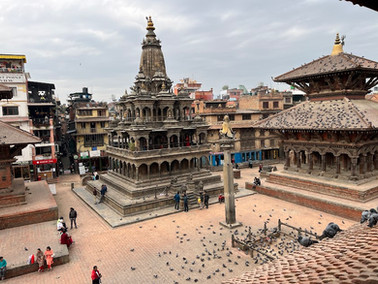

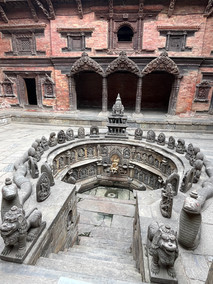








Patan's Durbar Square also suffered extensive earthquake damage from 2015, but we were immediately impressed with the intricate Newari architecture and attention to detail on the buildings surrounding us. The former palace now houses an incredible museum, which was easy to spend a full day at. Luke’s highlight was a picture of the first car that came to Nepal, showing Nepalese people lifting it over a river.






One negative about the change of seasons in the valley was that the air pollution levels were reaching hazardous. Well, they looked healthy when we compared them to Delhi’s air quality alerts, but it was still getting tiring being surrounded by a light haze and only rarely getting a glimpse of the hills and mountains we knew surrounded us. We decided to take a short journey toward Nagarkot, a popular hilltop town just 30km (18.6mi) from Kathmandu, and booked into an lovely eco homestay halfway up the hill.






While it was noticeably cooler, it was a lovely spot and nice to be out of the city. Our room was a treehouse with hammocks on the balcony, and the host family were extremely kind and made incredible food. We were still a small distance from Nagarkot, but surrounded by beautiful forest walking trails - it was a shame we had donated our boots already.






We took the local bus up to the hilltop for a ‘short hike’ which turned into 25km (15.5mi)! Although a little cloudy, we could see some epic mountains in the distance, and enjoyed a coffee break at a very fancy resort before a never-ending descent via military training camps and small villages to return home. We got a little bit lost, but some local girls at volleyball practice soon directed us toward the popular new swing bridge over the valley to get home again.
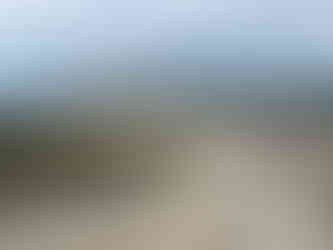






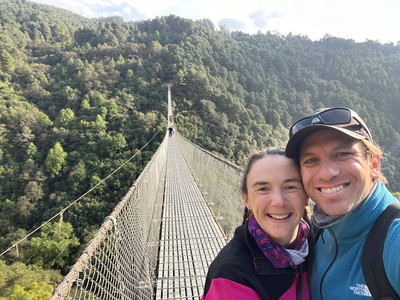
We fell into a nice, relaxed routine in this quiet spot, with Luke able to focus on his study for his project management certification, and Jelley able to catch up on overdue blog writing. It was so relaxing to be able to enjoy this beautiful part of Nepal in the tranquil forest. We felt so blessed to be able to wake up, go on short walks and eat delicious home cooked napelese food. Our new favourite dish we tried was ‘Momo soup’ - a flavorful dish featuring steamed dumplings (momos) filled with spiced vegetables, served in a savory broth enriched with herbs & spices. It was so good that we had it 3 days in a row!










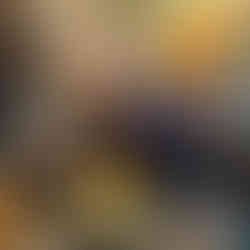

We had one last Durbar Square to tick off the list, and just 6 days left in Nepal! We were intrigued as to how different it could really be from the squares in Kathmandu and Patan already, but we were in for a treat! After waiting nearly an hour past the bus's expected arrival time for our trip back to Kathmandu, it finally arrived, packed full of people. We were certain there was no way we could fit in the already crowded bus, but the attendant waved us on and quickly threw our packs on top of the bus. Surprisingly, not only did we fit, but so did 30 more people we picked up along the way! Standing room only! When someone needed to get off, they were shoved out through the window, presumably to save time from unloading and reloading everyone. It was a very slow journey, but we eventually made it down to Bhaktapur. Lesson learned: "there's always more room."
Unlike the other two Durbar Squares, where there was an entry fee for specific buildings, Bhaktapur required an entry ticket for the entire heritage city, and it was expensive for Nepal at NPR1800 (USD$14) each. We were staying 2 nights here, and were again instantly impressed with the beautifully preserved buildings surrounding us, as we wandered through the streets to find our guesthouse. It was a nice change to have quiet streets, as Bhaktapur was majority pedestrian-only, with the exception of just a few motorbikes.






We were unsure about what to expect with the guesthouse we booked, as it was relatively cheap and only had a couple of reviews. We arrived at the back of a guest house down a long narrow alley way, and no one appeared to be home. We sat patiently in the reception area and, after some time, an elaborately dressed Nepalese woman arrived to let us in. She wore a stunning long red dress adorned with intricate golden wave patterns, complemented by beautiful golden earrings and matching shoes.
She approached us apologetically and said, “sorry to keep you, we are just in the middle of a family celebration." We weren't bothered as waiting around was a regular occurrence in Nepal. She went on to say, "it’s actually my daughter’s wedding day!" We extended our congratulations and best wishes. Yet she went on... "Yes, she’s 9 years old!" Our stomachs sank as we looked at each other, unsure how to respond to what we just heard."It’s actually my daughters 2nd wedding! You can join if you want?”
"Uhhhhh… what?!" we both responded. We were utterly perplexed by what we she was offered here. Was this lady really inviting us to witness her underage daughter's arranged marriage? She insisted we attend. We went up to our room and discussed with each other what we were going to do. Luke was extremely uncomfortable with the idea of attending a 9 year old’s wedding, especially after how disturbing it was seeing the "Kumari" living goddess a few weeks prior. But Jelley was intrigued and didn’t want to offend our host so eventually we agreed we would just go for 5 minutes and then excuse ourselves. We put on some semi-nice clothes and apprehensively headed up to the rooftop where the ceremony was being held.
We stepped out onto the rooftop of our guesthouse and joined the family, who were seated in a semi-circle on the floor. In the centre sat a 9-year-old Newari girl on a red square pillow. She was ornately dressed in traditional Newari wedding attire, an impressive tapestry of colorful fabrics that shimmered in the sunlight. Her hands and wrists were adorned with an assortment of golden rings and bracelets. Yellow and red flowers decorated her head and neck, complementing her fiery outfit. A red-ish orange paint covered her forehead and red lipstick and mascara accentuated her lips and eyes. She sat alone, apathetic, as her entire family gazed at her with admiration and pride. It was so incredibly awkward for us to be there. It was strange to see such a young girl dressed so elegantly. We were literally about to witness a 9 year old get married (apparently for the second time!) to some gross old guy.






The aunt and sister sat facing the child and wore similar red and gold gowns. They proceeded to prompt the girl with a series of peculiar tasks: igniting a ceremonial candle, tossing items over her shoulder, and more. There was even a wedding photographer pacing back and forth, capturing fleeting moments in the anticipation of the impending ceremony.
The family members warmly welcomed a couple of unfamiliar Westerners, and despite our attempts to engage in conversation, we found that very few spoke English. Eventually, another young woman joined us on the rooftop, proficient in English. She introduced herself as the bride's cousin, and kindly offered us tea, which we accepted. As she returned with our tea, we gathered the courage to inquire, "When will the groom be arriving?" She smiled at us and clarified, "He is already here, the son." Confusion swept over us, wondering if she was planning to marry another family member's son. Amused by our misunderstanding, she gestured upwards, explaining, "No, not a human boy. She is marrying the sun in the sky."
We looked at each other and laughed about what had just dawned on us. Had we just fallen for a prank? It suddenly became clear – of course, she's marrying the sun! The cousin continued to explain, "in Newari tradition, girls undergo three weddings. The first two are divine unions – one with a wooden apple (symbolizing Lord Vishnu), and the other with the sun. By marrying the sun, it's believed that the girl is safeguarded from the tragedy of widowhood, as the sun is eternal and never dies. The third wedding, a conventional one, doesn't occur until the girl reaches at least 25 years of age."
Needless to say, we were very relieved. We’re not quite sure if the mother knew quite how much she had shocked us! The rest of the ceremony was very cute and the sun did in fact show up for his big day. We enjoyed lunch together and were invited to join dinner celebrations with 130 of their other closest family and friends later in the day. They even put a special plate out for the sun to enjoy, but I don't think he was very hungry because the neighbourhood cats came and ate most of his food. It was incredibly kind and hospitable to invite us into their family occasion, and definitely a unique experience for us to enjoy. We even featured in one of their family portraits!






We were keen to wander around the old city before dinner, and whilst the town felt a little busy, it didn’t feel crowded. We enjoyed exploring the various temples - possibly the best yet! Bhaktapur had also suffered a lot of damage from the 2015 earthquake but it was in remarkably good shape all things considering.



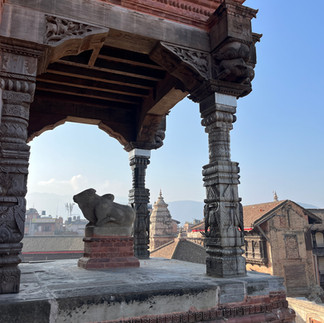


We woke early, and enjoyed having the town to ourselves and a handful of locals before the day-trippers arrived. After a walk around the 4 main squares, we stopped into a variety of small museums, including the wood museum and metal museum. We also stopped to a local Mandala school. Mandalas are intricate, detailed geometric designs used in Hindu and Buddhist rituals to represent the universe and serve as tools for meditation and spiritual guidance. They were really impressive, and we genuinely loved our time exploring Bhaktapur. We had wondered if we would be fatigued and simply over Nepal by this stage, but it continued to surprise us.












Our accommodation was in a brilliant location - from our rooftop we looked directly at the tallest temple in town and could just watch the world go by and the sun set straight from our rooftop. We spent a moment to reflect on our time here - this was definitely the longest we had spent purely travelling in one country, and while the difficulties of transporting around the mountainous regions did contribute to that, we genuinely loved all 86 days of our 90 day visa here.






Rooftops had become our favourite places in Kathmandu. We could sit here for hours and observe the world below and also the action on other rooftops! We returned to an easy (Western style) apartment in Patan for our final nights to be close to the airport, and returned to Boudha to farewell Eva who was also moving on from Nepal.
Unfortunately, our final moments of Nepal were a little tarnished with a taste of our next destination in the way we least expected. Jelley had a sudden onset of the renowned Delhi-belly at the airport, before we even made it to Delhi! It was an eventful exit from the country, but somehow we both made it through immigration and on the plane, ready for our next adventure in India.
Until then,

- A Kiwi and A Cali













Commentaires